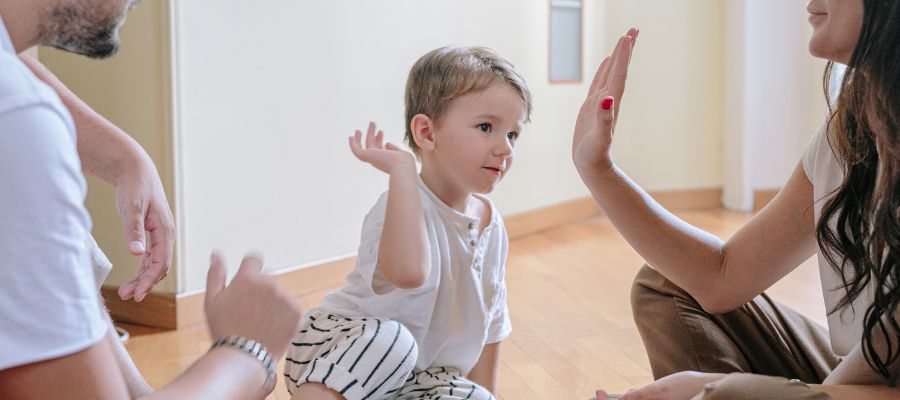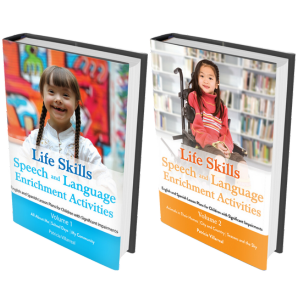We have all heard the term family centered approach. At the surface I believe that most professionals ascribe to the idea of putting the family first and working on the things that interest them most. However, the definition of “family centered” has evolved over the years. Secondly, there are huge benefits to our relationships with the families and the child’s progress when we do it well. We just need to be aware of some challenges.
In this essay, we are going to do three things: Let’s clearly describe what a family-centered approach is so that we can easily make it a part of our interactions and have the vocabulary to describe this beautiful process to the families. Then, let’s keep it real and honest and talk about the challenges that we face when shifting over to this model. And finally, we will end with some great ideas for making it a reality on your caseload.

Clearly Defining What Family Centered Approach Means
A family-centered approach for early intervention is a philosophy and practice that recognizes the family as the most important factor in a child’s development and well-being. The family tell you what they need and you focus on that. The family creates or at the very least dramatically influences the intervention goals. The family is the judge of whether or not progress is being made.
Here are key elements that define a family-centered approach:
1. Collaborative Partnership:
Professionals work in partnership with the family to plan and implement interventions. This partnership is characterized by mutual respect, trust, and open communication.
2. Respect for Family Choices:
Families are recognized as experts on their child and are actively involved in decision-making processes regarding their child’s intervention goals, strategies, and services.
3. Individualized and Culturally Responsive:
Interventions are tailored to meet the unique needs of each child and family. This includes considering cultural, linguistic, and familial values and practices.
4. Strengths-Based:
The focus is on identifying and building upon the strengths and capabilities of the child and family rather than solely on deficits or challenges.
5. Continuous Support and Information Sharing:
Families are provided with ongoing support, information, and resources to help them understand their child’s development and progress. This includes empowering families to advocate for their child’s needs.
6. Coordination of Services:
Professionals collaborate across disciplines and agencies to ensure that services are coordinated and integrated to best meet the needs of the child and family.
7. Promotion of Family Well-Being:
Recognizing that the well-being of the family as a whole impacts the child’s development, interventions may include supports and services that address the broader needs of the family, such as emotional support, parent education, and access to community resources.
8. Respect for Diversity:
Embracing diversity in all its forms, including family structure, language, culture, socioeconomic status, and beliefs, and ensuring that interventions are inclusive and equitable.
In a single statement:
A family-centered approach emphasizes the importance of supporting and empowering families to promote the optimal development and well-being of their children. It acknowledges that families play a critical role in their child’s early intervention journey and strives to build a supportive and collaborative relationship between professionals and families.

Potential Challenges of Implementing a Family-Centered Approach
Sounds perfect, right? Who wouldn’t want a professional to enter their home and create an intervention experience that is centered on their own needs? Alas, there are the realities of home-visits that sometimes take the wind out of the optimism sails. It can still be done, and as we write about in our Early Intervention Guidebook, success is dependent on seeing the progress you hope to make in the context of the family routines.
Here is a sort-of checklist to think about if you not making a strong connection with your families and seeing the progress you would like:
1. Differing Expectations and Perspectives:
Professionals and families may have different expectations, priorities, or perspectives regarding the child’s needs and the appropriate interventions. Bridging these differences requires effective communication and mutual understanding.
2. Time and Resource Constraints:
Limited time and resources can impact the extent to which professionals can engage in meaningful collaboration with families. This can hinder the development of strong partnerships and personalized interventions.
3. Training and Development:
Not all professionals may have received adequate training in family-centered practices. This can lead to varying levels of proficiency in engaging families and implementing collaborative approaches. Families may also be new to communication strategies and would benefit from having some tips on how to communicate better.
4. Cultural and Linguistic Diversity:
Families come from diverse cultural and linguistic backgrounds, and professionals need to be culturally competent to effectively communicate and collaborate with all families. Language barriers may also present challenges in ensuring effective participation and understanding.
5. Respect for Family Choices:
While respecting family choices is a core principle, there may be instances where professionals and families disagree on the best course of action. Balancing professional expertise with respect for family decisions can be complex.
6. Navigating Complex Family Dynamics:
Families may experience various challenges such as stress, trauma, or socioeconomic issues, which can impact their ability to fully engage in the intervention process. Professionals need to be sensitive and responsive to these dynamics.
7. Access to Services and Supports:
Disparities in access to services and supports, including geographic limitations, financial constraints, or lack of available resources, can affect the extent to which families can participate in and benefit from family-centered interventions.
8. Evaluation and Accountability:
Traditional models of evaluation and accountability may prioritize quantitative measures or standardized outcomes, which may not fully capture the holistic benefits of family-centered approaches.
9. Resistance to Change:
Adopting a family-centered approach may require a shift in organizational culture or practices within service delivery systems. Resistance to change from professionals or within institutions can hinder the adoption of family-centered practices.

H2 How Do We Encourage ‘Buy-In’ From Families to Keep Them at The Center?
We have had the opportunity to team up with all types of caregivers in implementing intervention for young children with communication difficulties. These are parents, grandparents, foster parents, and even nurses in life skills classrooms that play a role far greater than their nametag suggests.
While searching for the “best way” to collaborate, we have come to realize that we can achieve a kind of synergy when we fully involve parents and caregivers. Synergy, by definition, is when one or more components are combined to create a product that is even greater than the effects they would have if they were added up individually. Simply put, teaming with parents and caregivers gives you the most bang for your buck. Better progress is seen at a faster rate.
1. Interview the caregivers
It is almost always the case that they want to help; that is rarely a problem. To have successful collaboration, we have to explain the what, the how, and the why of communication intervention. Before we can do this, we first have to determine how the caregivers view and understand their children’s communication behaviors, and what they know about helping their children improve their communication skills. In other words, we need to assess the caregivers.
This is done by posing open-ended questions to provide families with an opportunity to tell their story. By listening to them and observing their interactions with their children, we gain valuable information about how to approach collaboration. After making this initial assessment, our next step is to provide them with the knowledge and tools that we use as professionals to help their children improve their communication skills.
2. Package up our ideas and present them in a way that makes sense.
The first thing we can do is assure parents and caregivers that they are not the reason their child has difficulty communicating, as well as provide positive reinforcement for their efforts to help their child. Parenting is not easy and parenting a child who requires special care presents an added challenge.
3. Avoid making assumptions.
Whether you are a speech-language pathologist, early interventionist, or other professional, you likely have immersed yourself in a discipline that comes with a specific knowledge base, terminology and perspective. To work with caregivers, you need to step outside of your world, throw your acronyms out of the window, and start from the beginning. The ‘beginning’ is usually different for each caregiver.
4. Remember that collaboration is a process.
When you learned about your discipline, even if you were immersed and bombarded with information, your actual understanding and skills were formed across many months, even years. Collaboration is not a ‘one-time thing.’ It requires patience, empathy, and a true commitment. As you can see, it involves many of the qualities we use when working with the children themselves!
5. Take risks.
We are accustomed to teaching children. We give them instructions with great ease and comfort. We ask them to do things without hesitation. In working with caregivers, the nuance of achieving a working relationship varies based on personalities, cultural factors, and learning styles. Regardless, it requires some level of confidence in the value of what you know and do, and the importance of sharing your ideas with other adults. Invariably, this requires some level of risk-taking. Do it. Be up-front with people. Tell them that we will try things together, some of which will work better than others. We take risks together as a team. Change requires trying new things and taking risks.
We are so happy to see this idea catching on everywhere. Here is a great summary video from the New York City Health Department:




